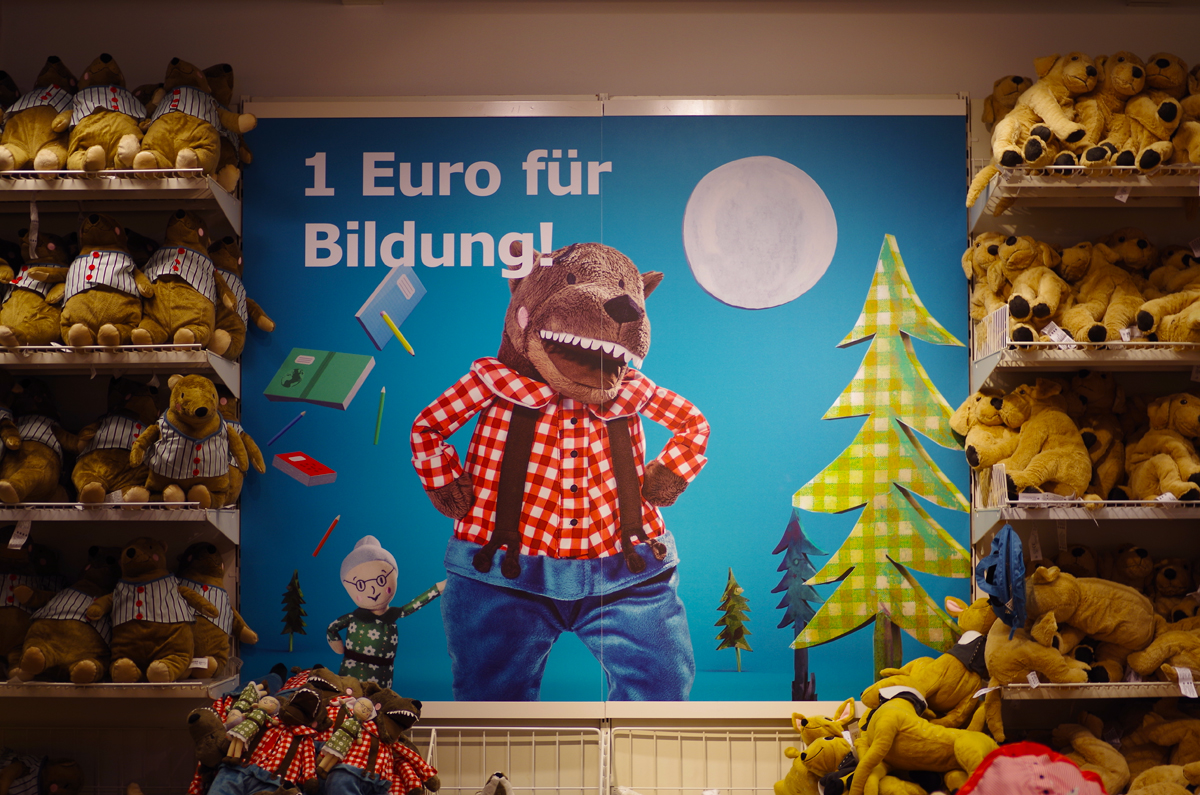Who could argue with such a simple request? “1 Euro for education”, the sign reads, advertising IKEA’s ongoing commitment to donate that amount to Save the Children with the purchase of each soft toy. But given the context, it’s hard not to read the message as a disturbing double entendre. Because in a currency union that Germany dominates, this statement reads like a précis on cultural imperialism in post-Cold War Europe.
Bildung, after all, doesn’t just translate as the largely value-neutral English term “education”, but also as the sort of attainment that divides the haves and have-nots in the subtler realm of taste. Historically, the acquisition of Bildung has been kept separate from the acquisition, as the plots of many a Bildungsroman attests.
Having money didn’t hurt, of course. But it was by no means a prerequisite for being a person of Bildung. Indeed, many highly educated Germans practiced a kind of snobbery in which too much wealth — particularly the sort that is too quick to display itself publicly — was regarded as a cultural affront. As was the case in many European countries, the intelligentsia prided itself on indifference to the base pursuit of lucre.
But times have changed. In a world where national pride is measured less and less in cultural achievement and where, concomitantly, public funding for the arts is in steady decline, status is increasingly indexed by the power of the purse. Germans take pride in the fact that they haven’t fallen prey to the temptations of Europe’s less functional economies and measure their self-worth less by the amount they know than the amount they have in the bank.
At least, that’s the impression given by critics of German complacency, both from within and without. It’s as if the nation had morphed into a perverse hybrid of nineteenth-century liberalism and twenty-first century technology, a place where Bildung can be measured in bank balances.
To be sure, this is true of trends throughout the developed world, consistent with late capitalism’s discovery of the fountain of youth. Given the animus against Germany’s fiscal hegemony, however, the charge cuts deeper in the domain of the Bundesbank. Where once sentimentalists wondered how a people that gave the world Bach and Beethoven also gave it Hitler, now they ask how they can be stamping out cultural diversity, particularly among frustrated European youth in the Mediterranean countries, in the name of the balance sheet.
It’s worth recalling that the establishment of the eurozone was preceded by another currency union. In the wake of the German Democratic’s Implosion in 1989, a great deal of discussion was had about the future of the East. Intellectuals on both sides of the rapidly dissolving border advocated for a Third Way, preserving what was good about the socialist legacy and preventing the sort of economic and cultural disadvantages that often accompany the end of civil wars, whether “hot” or “cold”.
But the realization that many of these advocates had ties to the GDR’s security apparatus undermined the dream of the Third Way on one side, just as corporate interests were eating away at it from the other. In the end, reunification was driven, not by a delicate engagement with cultural differences, but the one-size-fits-all motor of the Mark.
West and East Germany were forced back together without regard for the effects of their citizens’ ideological training, as if a shared currency would be enough to create a level playing field for all. In practice, however, despite the rise of many former East Germans, like Angela Merkel, to political prominence, the divide between the two nations has never really been bridged. Ossis are poorer than their counterparts in the West, less educated and more likely to be lured by political extremism.
Now we are witnessing a similar phenomenon playing out across the eurozone, with Italians, Spaniards and, most prominently, Greeks railing at their second-class status and the economic measures that promise to entrench it further. It’s no accident that educational institutions in these countries are hotbeds of resentment towards the Euro and the bully that maintains its power. To young people whose hopes for the future are being extinguished before they even finish school, the very idea of a “Euro for education” is a bitter irony.
There’s also cognitive dissonance attached to IKEA’s involvement in this campaign. Whatever the corporation’s global read, its branding remains relentlessly Swedish, from its color schemes to the whimsical names its products bear. And Sweden, like Denmark and the United Kingdom, remains one of the few nations in Europe to resist the Euro’s imposition. The company may donate a Euro for each purchase of a soft toy, but its ledger is still tallied in kronor.
Photographs courtesy of Joel Schalit






